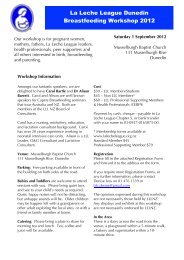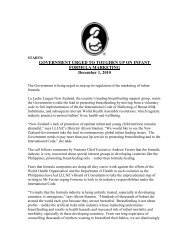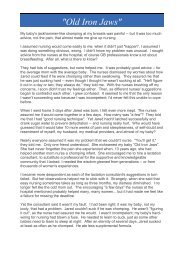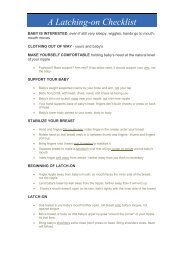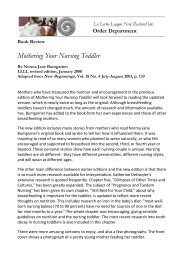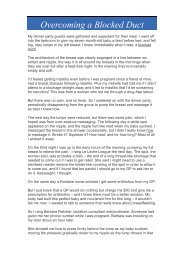"My Baby Just Doesn't Get It!" [Diane - La Leche League New Zealand
"My Baby Just Doesn't Get It!" [Diane - La Leche League New Zealand
"My Baby Just Doesn't Get It!" [Diane - La Leche League New Zealand
You also want an ePaper? Increase the reach of your titles
YUMPU automatically turns print PDFs into web optimized ePapers that Google loves.
"<strong>My</strong> <strong>Baby</strong> <strong>Just</strong> <strong>Doesn't</strong> <strong>Get</strong> <strong>It</strong>!"<br />
There are lots of reasons why a baby can't seem to get the hang of latching on and<br />
nursing well at first. While your baby learns how, you need to:<br />
1) keep him fed,<br />
2) keep your milk supply going,<br />
3) keep in touch with breastfeeding specialists... and<br />
4) keep the faith! Your baby will learn how. These babies did.<br />
Emily just didn't get it. She would root, but she didn't seem to understand latching on.<br />
Like almost all nonnursing babies, she could suck just fine on a finger. Her mother<br />
worked on positioning, and began using a rental pump to make sure her milk supply<br />
would build whether or not Emily began nursing soon. She bottlefed Emily, using<br />
formula to supplement her stilllow supply. Over the next few weeks, she tried different<br />
positions, a nipple shield, a feeding tube, and finally just stopped trying for a week. "Look,<br />
Emily," father said to daughter, "The whole world sucks. There's no reason you can't." A<br />
little more time with the nipple shield, and Emily started nursing. <strong>It</strong> took her a bit longer<br />
to become fully competent, so her mother continued to pump and offer an evening<br />
bottle. By 6 weeks, the formula and the breast pump were gone.<br />
Daniel just didn't get it. He would try and try to latch on, then give up in frustration. After<br />
just one visit from a lactation consultant, Daniel and his mom "got it together". <strong>It</strong> was a<br />
simple matter of positioning.<br />
Timothy just didn't get it. His mother had "easy" nipples and plenty of milk, but Timothy<br />
couldn't stay latched on at first. Even though she could sometimes pump 10 oz at a<br />
sitting, once Timothy learned to latch he could suck and suck, and not swallow a drop!<br />
Over the first month, Timothy's nursing skills kept improving, and he began swallowing<br />
sometimes. By 7 weeks, Timothy was pretty competent most of the time. His mother<br />
pumped for an evening bottle for a few weeks, but then Timothy started refusing it. The<br />
boy who started out not knowing how to nurse ended up not liking bottles!<br />
<strong>La</strong>ura just didn't get it. Her mother finally was able to get her to latch on by using a<br />
nipple shield. At first, she gave additional pumped milk in a bottle. But <strong>La</strong>ura's mom was<br />
soon able to maintain a full supply without pumping, even though <strong>La</strong>ura nursed with the<br />
shield. After 6 weeks of using the nipple shield and occasionally being offered the breast<br />
alone, <strong>La</strong>ura was able to nurse without the shield. (Caution: for some mothers, regular<br />
use of a nipple shield without pumping results in a lower and lower supply. Use a nipple<br />
shield only with guidance from a breastfeeding specialist.)<br />
Ali just didn't get it. She latched on in the first few days but didn't nurse well, became<br />
dehydrated, and refused from then on. Her mother pumped, bottlefed her, and kept<br />
trying. No luck. Ali either screamed or slept whenever the breast was offered, and<br />
seemed to have no idea how to draw in her mother's rather flat nipples. At 5 weeks, her<br />
mother switched to fingerfeeding her with tubing, to break the bottle habit and accustom<br />
her to the feeling of skin. A few days later, provided she was asked and not told, she<br />
began accepting a nipple shield with tubing to provide instant milk. After a few days with<br />
the shield, she simply started nursing, first on one side, then both. And that was that.
Minda just didn't get it. Her mother had large, soft breasts, with nipples that didn't stand<br />
out at all. Minda's mom tried many positions, a nipple shield, fingerfeeding, bottle<br />
feeding, and by 5 weeks was ready to quit. She tried a feeding tube at the breast as a<br />
last resort, and it turned out to be the "latch on here" signal Minda had been looking for.<br />
<strong>It</strong> took another week of ups and downs before Minda nursed consistently and easily.<br />
Alex just didn't get it. He would fight and cry at the breast, and his mother's milk supply<br />
dropped really low. His mother fingerfed him with tubing, alternating time on her finger<br />
with offering the tubing at her breast. She used a hand pump, and supplemented her low<br />
supply with formula. By about 4 weeks, Alex would latch on some of the time. Suddenly,<br />
things began to click. His mother continued to use tubing at her breast to supplement<br />
him while her own supply increased. From the day he really began nursing, Alex sat in<br />
his mother's arms like a different baby relaxed and content, as if he'd found heaven.<br />
Alex loved being a nursing baby.<br />
Lisa just didn't get it. Her mom kept her wellfed by using a rental pump and cup<br />
feeding. <strong>It</strong> was a discouraging first week, with lots of spilled milk and the tedium of<br />
pumping, but by the end of the week, Lisa was an accomplished nursing baby.<br />
Brandon just didn't get it. He hadn't had any good nursings in the hospital, and couldn't<br />
latch on at all after they got home, because her breasts were engorged. She used a<br />
rental pump to soften her breasts, and, with some positioning help, Brandon latched on<br />
and nursed beautifully. Without the lactation consultant's help, and with breasts still very<br />
full, they had trouble again. But she kept pumping, and gave Brandon her milk with an<br />
eyedropper when he couldn't nurse. After a few days, that early engorgement was over<br />
and nursing was easy.<br />
Shira just didn't get it. She would root, then make a face and push her mother's nipple<br />
away. After a week of trying, and offering pumped milk in a bottle, her mother began<br />
using a nipple shield. During the next week, Shira nursed with the nipple shield and<br />
usually enjoyed it, but had to be supplemented by bottle. Sometimes she refused the<br />
shield. Then her efficiency with the shield began to improve, and she began accepting<br />
her mother's bare breast sometimes, partway through a feeding. One morning, at about<br />
2 weeks, she just "seemed different" to her mother. And she nursed well from then on.<br />
Bruce just didn't get it. He couldn't seem to draw his mother's breast into his mouth and<br />
keep it there. After a few days he managed to nurse with a nipple shield, but he was<br />
supplemented with bottles of pumped milk as well. Day after day went by, and his<br />
mother wondered if she would ever be rid of the shield and bottles, but suddenly, in the<br />
bathroom, a day before his four week birthday, Bruce just started nursing. <strong>Just</strong> like that!<br />
The things these babies' mothers had in common were tears, determination, plenty<br />
of skin contact with their babies, and help from a knowledgeable breastfeeding<br />
specialist. Each pair followed a different path to breastfeeding. Some babies<br />
caught on quickly, some needed long and frustrating weeks. But all these babies<br />
went on to enjoy breastfeeding... And all their mothers say it was worth the wait.<br />
©2001 <strong>Diane</strong> Wiessinger, MS, IBCLC<br />
136 Ellis Hollow Creek Road <strong>It</strong>haca, NY 14850<br />
Used with permission


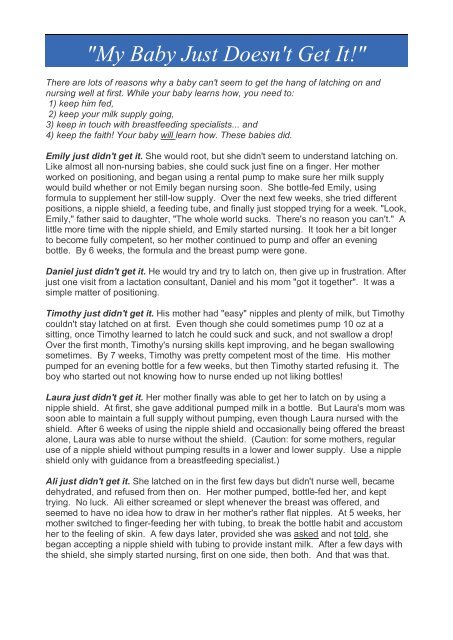
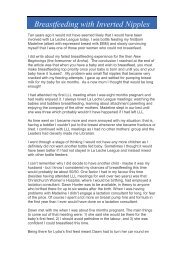
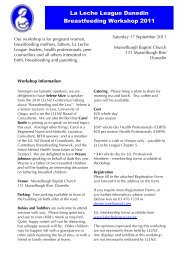

![Pacifiers [Diane Wiessinger] - La Leche League New Zealand](https://img.yumpu.com/24771496/1/184x260/pacifiers-diane-wiessinger-la-leche-league-new-zealand.jpg?quality=85)
